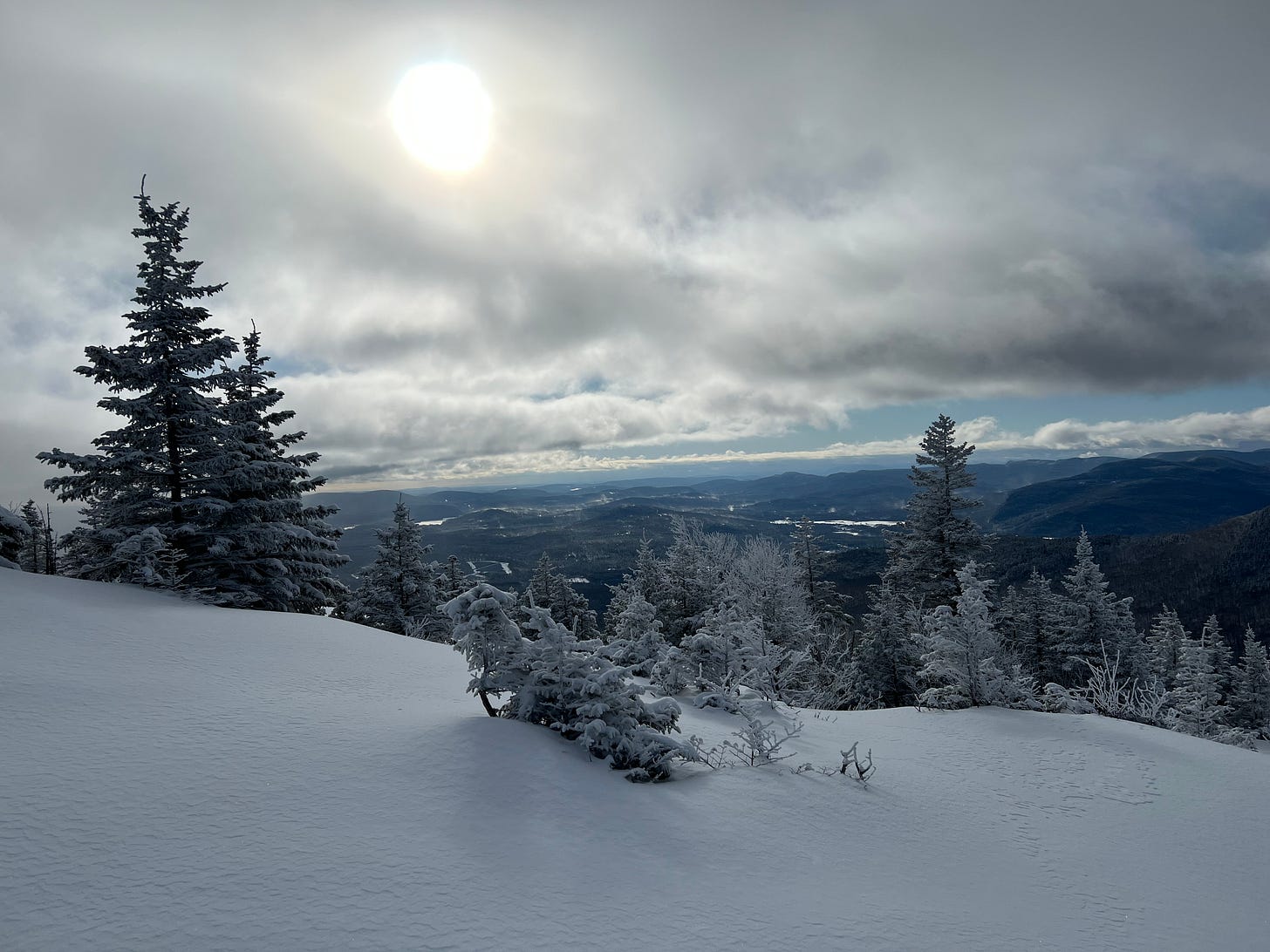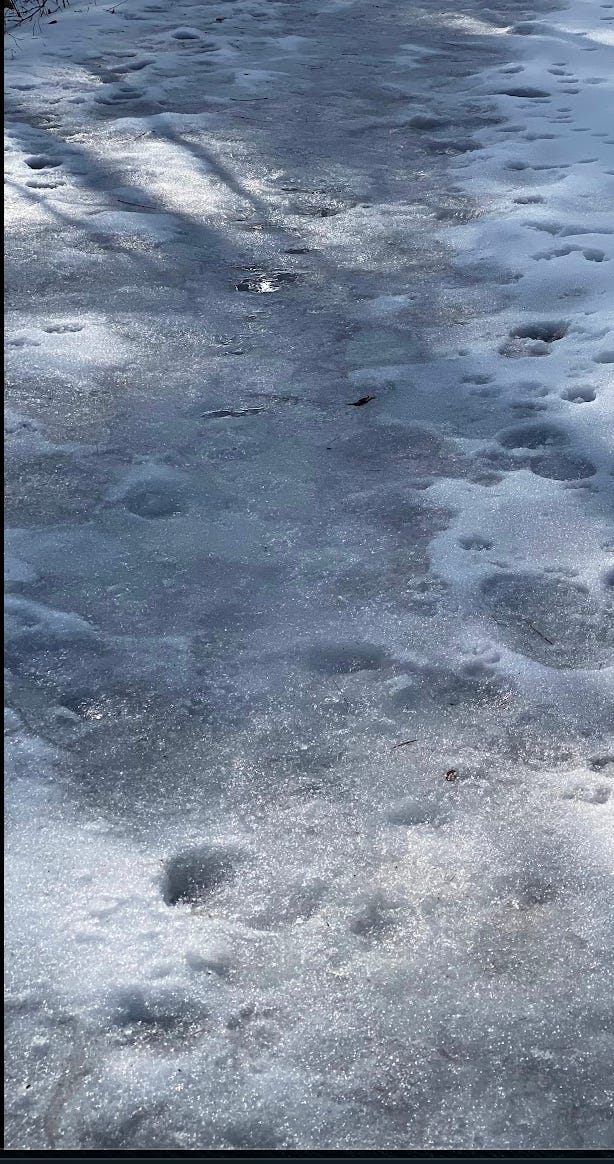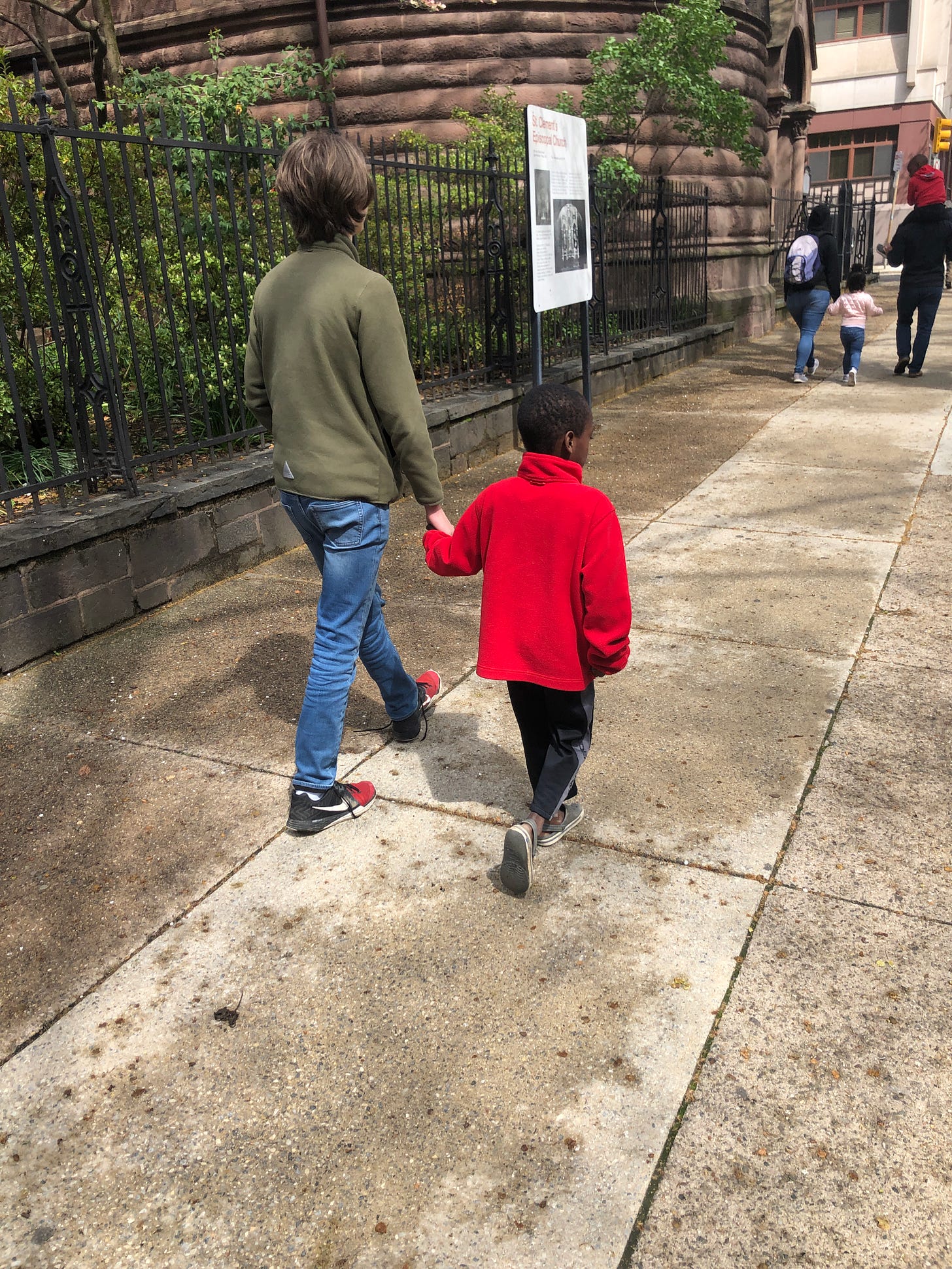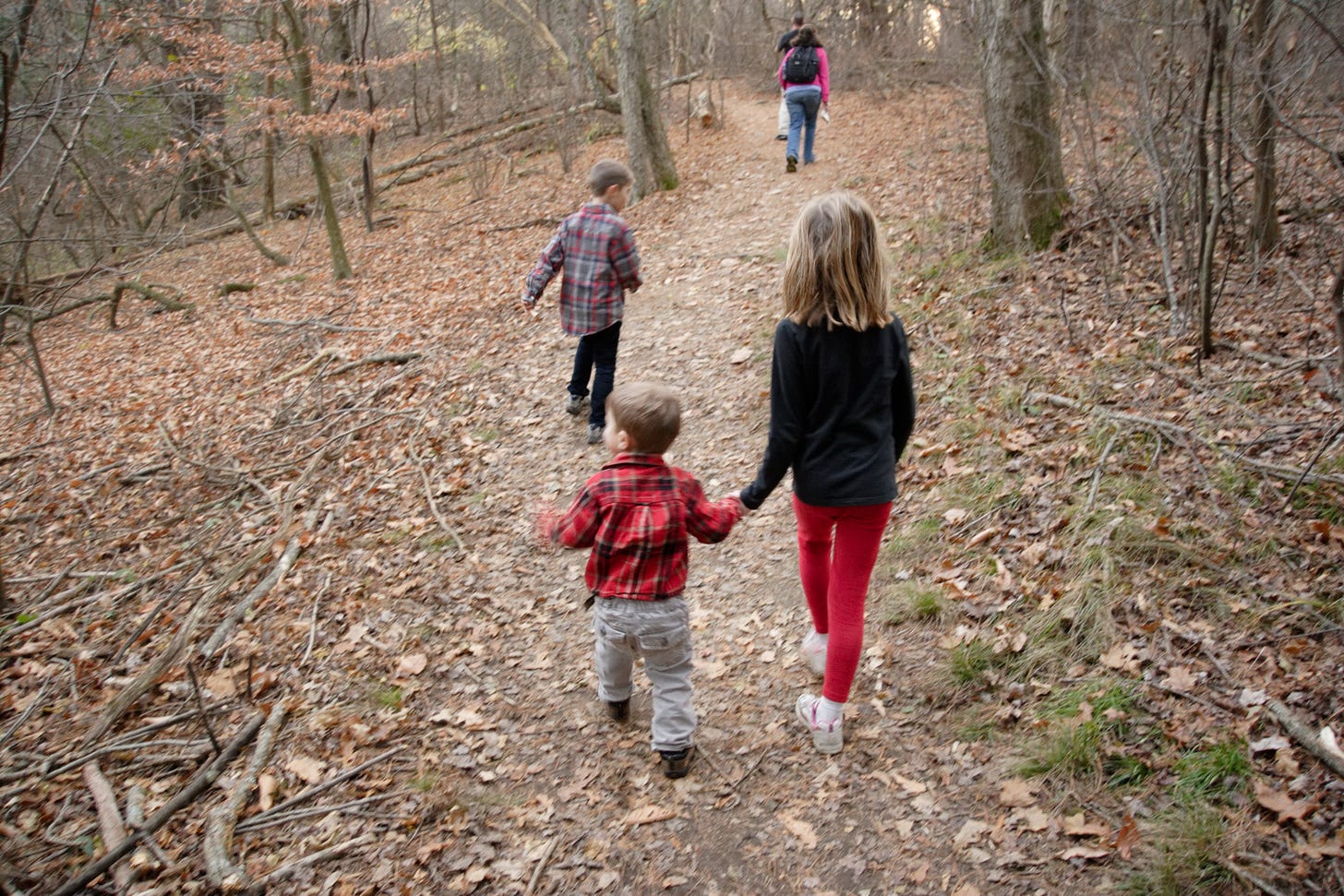
Snowflakes are six-sided crystals, as much air as they are frozen water. The icy water molecules form around a dust or pollen molecule floating through the sky, bonding together always in a hexagonal shape. While the structure is the same, each snowflake is unique, responding to the environment around them to create their own, individual form. When the air is colder, the snowflakes are smaller and more air gets trapped between the crystals, landing as fluffier, lighter snow. These crystals, falling, even dancing down to cover the ground, are translucent, and the light bounces off their six points. The way the light scatters once it hits a snowflake, sending all the color frequencies back out into the atmosphere, creates the bright white snow. If you have ever been outside when the snow has blanketed the hard frozen ground of winter, stood on a fresh layer of those icy crystals, you know the quiet, the peace that you feel. Those air pockets within each snowflake trap sound waves and muffle them, creating a silence that is so rare in our busy, sound-filled world. In fact, snow is able to almost completely absorb all sound if it is just the right type. The piercing coolness on your cheeks, the way even the moisture in your nose can crystallize if it’s cold enough, the visibility of your very breath as its warmth meets the brisk cold air. The hush. The pristine and sparkling white of untouched snow. The pause and stillness of it all.
This is one of my favorite places to be.
This past winter has not had enough of this. To be fair, I have not had my usual amount of time in the mountains, where this is a far more common occurrence. The demands of a new job, the busy lives of teenagers, all of this has made it harder to escape for a weekend and spend time in the snowy mountains.
But this past week, winter has shown her least favorable sides. Two storms, only a few days apart, that began as snow with several inches accumulating, then cycled through sleet, freezing rain, and then just cold rain before temperatures dropped again and froze all that moisture. By Monday, we had more ice than pavement in driveways and sidewalks around town. My walk Monday afternoon was treacherous and would have been better accomplished on ice skates. To fill out the cruel and bitter triumvirate, the temperatures were raw and the wind was fierce and strong. Ice, bitter cold, and windy—these are the sides of winter I do not like.
So ominous was this combination, I did not even attempt to walk on Wednesday and Thursday, but waited until the sun burned a little brighter and warmer on Friday, the wind having mostly departed, the temperature climbed up above freezing, and the ice started to change from a hard, slippery solid to a cold, streaming liquid.
How remarkable that the same three molecules—two hydrogen and an oxygen to be exact—can create such varied forms depending on their environment.
This week, although a shorter work week with the holiday on Monday, somehow felt long. The boys both had the week off from school and while in the past, we would’ve taken at least part of the week to ski, I don’t have any time off yet and skiing is not something M enjoys. M busied himself with redoing his closet, removing shelves that D had installed years ago before a third child occupied that room, removing the last of the wallpaper left from the previous owners, spackling and sanding the walls, and then painting the small space a very dark gray. L set off on his own adventure, skiing with two friends in New Hampshire, less affected by the bitter cold and more driven by the promise of two days with good friends. Z was back at school, navigating the icy sidewalks and bracing against the wind coming off the wide river he crosses daily to get from his dorm to classes. Work was busy, a good kind of busy that felt mostly productive and useful, lots of good conversations with coworkers, therapy sessions that felt positive. But the heaviness of the world was reflected in the view out my window—frozen, hard, unrelenting, fiercely cold, and treacherous.
I asked a colleague a week or so ago if we should proceed as if…as if the whole foundation of our government isn’t shifting, as if we aren’t worried we might receive an email and voicemail from someone we’ve never met, who clearly knows nothing about what we do or how our job benefits others, saying that we no longer have this job. As if the job is the same as it was on January 17. Yes, she responded. Because what else can we do? We can’t predict when or if the cuts will come to us, if the exemptions we now fall under will change tomorrow or next week or next month. We can’t and don’t want to stop delivering the care we provide, the programs we offer, the training of the next generation of healthcare professionals, the support we give to each other.
So many people I know are affected by this pointless and heartless decimation of the fabric of our country. Professors and researchers who have worked for years to develop critical research programs that are being senselessly cut. Grants they have worked on for years not moving forward in a review process or the funding being reduced in a way that makes continuing almost impossible. Salaries being dramatically reduced. Jobs lost. Parents who are terrified about their children’s healthcare disappearing. Their identities being threatened, erased. People who work in programs to support children, immigrants, unhoused individuals, people struggling with addiction, older folks, victims of crime, the less resourced among us. People who work in schools, hospitals, on cancer trials. I have read the stories of park rangers who were fired from their dream jobs. Of USAID workers forced to leave programs with almost no notice, to come back to this country and be told they have no job. So many other stories that could be shared. So many people whose lives are being gutted.
It is overwhelming. Senseless. Destructive. Devastating.
How can humans be so cold? So detached from empathy? How could power or money or whatever it is that is driving this rampage be so much more enticing than the feeling you have when you see a baby? The purity, innocence, and hope in that small perfect face. The whites of their eyes without a blemish, the heart that hasn’t yet understood the cruelness of the world? The feeling that comes when you stop on your walk because you see an older man struggling to get his two heavy buckets of ice melt up his stairs. Despite his protests that he can take care of it, you can see his body is beyond that type of activity. So you pick up the buckets and bring them just inside the door, where you are greeted by his wife. She explains that she had broken her femur a few months back and is still recovering. That he is doing everything he can to support her recovery, but they are older and things are getting harder. You bring the groceries that he has carried up to the front porch inside, place them on the kitchen table, ask if she needs help putting things away. She declines the help, but expresses gratitude for the help you have already given. And because a storm is coming tomorrow, you ask if they have help shoveling. Yes, they assure you—the neighbors are wonderful. And so, you leave these two people and resume your walk. That feeling of being useful, filling in a space that someone else couldn’t, isn’t that worth more than money? Isn’t that worth more than the surge of power?
As humans, we are born into this world defenseless, completely dependent on others to feed, clothe, shelter, and care for all of our needs. When physical and emotional resources are plentiful, most caregivers do these things. When they are not, a child grows up understanding that they will be responsible for meeting their own needs or finding someone else who can. For a child who experiences failures in their care, whether complete or intermittent or anywhere in between those extremes, trust becomes more complicated. Sometimes, so hungry are they for care and belonging, they trust too quickly, placing all their built-up needs on another before they really understand to whom they have handed over their vulnerability. Sometimes, they become hyper-responsible, hyper-capable and try fervently to eliminate any dependence on others. Trust becomes something given rarely, only after many tests of its endurance. These hyper-competent and adept individuals are keenly attune to failures of trust. Their brains assure them they need this level of sensitivity to survive. And so, when trust is given, it is given fully because the process of trusting another human is so thorough and exhausting, it doesn’t happen often.
We develop these habits of interaction and communication for specific reasons, specific circumstances. And while they may have made sense when we first developed them, they are often no longer a great choice for the current situations in which we find ourselves. A child who grew up with food insecurity may eat quickly and more than they need because they continue to operate from that place of not knowing when or from where their next meal will come. To redirect ourselves to new ways of interacting, we have to become aware of our patterned behavior, understand what drives or activates it, and then create a new way of responding. It is hard work. It takes time. It often brings up a lot of sadness and disappointment around the experiences that caused the response in the first place. The lack of resources—food, safety, comfort, consideration, love, belonging. The experience of violence—emotional, verbal, physical, sexual. The absence of care because of a caregiver’s addiction, depression, other mental illnesses, just plain lack of skill. Prejudice and discrimination—seeing someone as less than because of how they identify, who they love, where their families originated, how they look, what resources they have, and then treating them differently, abusively because of those differences. When we experience these things, our brain works hard to protect us. To make the best choices given the resources we have available to us. And then, if those dangers subside, our brain becomes vigilant to any suggestion that we are about to experience something similar.
It is hard to learn to trust when your experiences have taught you that to do so is dangerous. That trusting others can lead to threats or actual experience of violence against your integrity, well-being, body. But it can be done. I have seen it over and over again. Because most people are kind. Most people do want to care for and support each other. Most people care much more about your smile and genuineness than who you love or how you identify. And most people will make mistakes, forget things that are important, fail us in small and sometimes big ways.
This is what gets me out of bed in the morning. My trust in the power of connection between people. The hand of a younger cousin held by the older one. The bonds created not by shared DNA but by love and a choice to be family. The simple act of saying, you are important to me. In those conjoined hands is a promise, a commitment to stay together, walking along the same path, seeing the same things, but experiencing the world in different ways. Because one is older, one is younger. Because the assumptions made about each will be different. The hope and love and joy all contained in the mama’s hand holding her exuberant daughter’s tiny fingers. The brother’s view, perched high up on his adoring papa’s shoulders. The future that we could all have if love and kindness was what pervaded our lives.
When it’s bitterly cold and the wind is fierce enough to bring down power lines, leaving people without heat and power, when the predominant form water has taken is ice with its slick surface and ability to bring down even the most agile of us in a single step, it can be hard to remember that spring will arrive. That beneath the hard frozen surface are bulbs, storing energy to burst through the soil with the promise of a green shoot, then leaves, a bud—cloaked in green before blossoming into the beauty of a flower. That even the ice can be conquered with a thin blade, cutting through to create a smooth, gliding path. Artists and athletes alike perfect this movement, racing across the ice, deftly sliding between opponents to slam a small round puck into a goal or spinning rapidly, back arched, head pointing to the sky, arms outstretched, demonstrating just how beautiful the human form can be. The snow glistens and sparkles in its purity because it reflects all the light equally, not absorbing or deflecting one color over another. The wind can be harnessed to produce energy that can create the heat in our homes, turn the lights on, run our internet connections. Cold can be met with the warmth of a down jacket, the knitted cable hat that keeps the heat from leaving our heads, the softness of thick winter mittens.
We will need people who can glide across the ice, who know how to navigate its slickness and are skilled at using the surface as a way to create sport and art with the understanding of how to win. We will need to come together and create a blanket across our country, to remember that when all light frequencies are reflected equally, we are one and the same, the sparkling whiteness of snow. And in those pockets of air that exist between the crystallized snow so much sound is held—the sound of a people who are not going to let their country go quietly. That eventually, the cold and starkness of winter will give way to the rebirth of spring. Life will blossom again. The leaves will erupt with small buds that will eventually envelop them in green. The bare ground will soon be carpeted with grass, punctuated by the oranges, yellows, peaches of daffodils; the brilliant reds and yellows of tulips; the heady scented pinks, deep purples, and pristine whites of hyacinths. And that snow, that ice, will join together and rush over rocks, wind through forests and over mountains, currents racing to continue the push of progress.
We will need to take each other’s hands, hold tight, and trust. Trust in the same way a child, just learning to walk, trusts that their parent will support them, keep them from falling, and help them to learn to eventually, let go.
We’ve got this.
As long as we take the hand next to us, hold tight, and take the next step forward.
All photos were taken by the exceptional Dana Giuliana, unless otherwise noted.
Thanks for spending some of your day reading this post. I hope it resonated. Periplum of motherhood and other wonderings is free. If you enjoy reading, please share it with friends, leave a comment or a heart!







So full of deep thoughts accompanied by D’s great photography. Penetrating thoughts on connection and sizmic changes in our world. Justifiable worry for the healthcare for our loved one’s threatened by souless oligarchs and wannabe kings. We carry on as we see daffodils pushing up in the garden. So must we❤️
Continuing to hold hands... <3